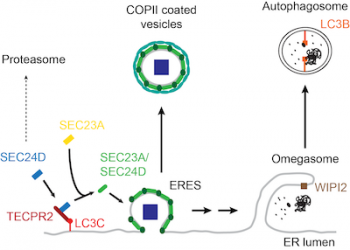01 Oct 2015 - TECPR2 links early secretion pathway and autophagy
Hereditary spastic paraplegias (HSPs) are a diverse group of neurodegenerative diseases that are characterized by axonopathy of the corticospinal motor neurons. A mutation in the gene encoding for Tectonin β-propeller containing protein 2 (TECPR2) causes HSP that is complicated by neurological symptoms.
While TECPR2 is human ATG8 binding protein and positive regulator of autophagy, the exact function of TECPR2 is unknown. As published in the latest issue of Molecular Cell, the group of Christian Behrends revealed that TECPR2 interacts with the COPII coat protein SEC24D to stabilize components of the COPII coating machinery.
In cooperation with lipidated LC3C, TECPR2 is required for maintaining functional ER exit sites and efficient ER export. Moreover, TECPR2-deficient HSP patient cells display alterations in SEC24D abundance and ER export efficiency.
Additionally, TECPR2 and LC3C are required for autophagosome formation, possibly through preserving functional ERES. Collectively, these results disclose that TECPR2 functions as molecular scaffold linking early secretion pathway and autophagy.
